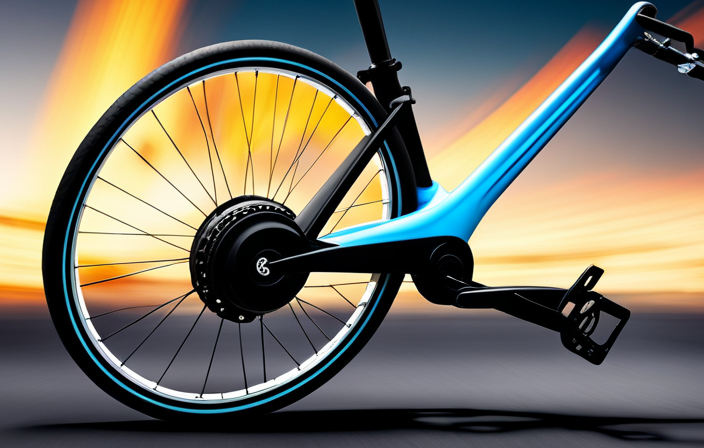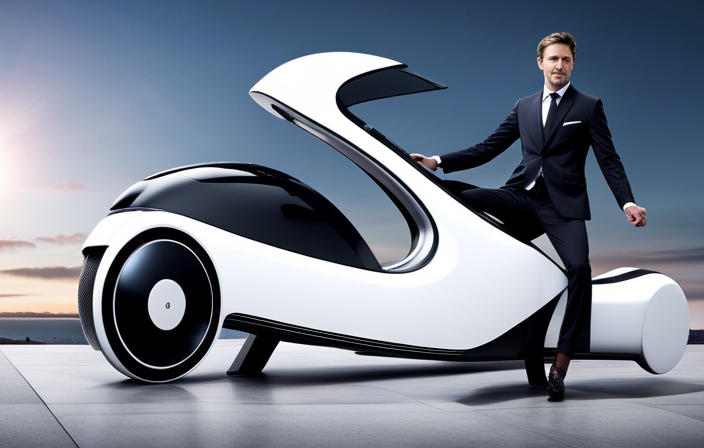Are you thinking about purchasing an electric bike but unsure of which class is best suited for your needs? It is important to understand the various classes of electric bikes in order to make an informed decision.
In this article, we will delve into the details of each class, including their power and speed limitations, maintenance requirements, environmental impact, and the overall riding experience.
By the end, you’ll have a clear understanding of the various classes and be able to choose the perfect electric bike for your needs.
Key Takeaways
- Class 1 e-bikes provide assistance only when pedaling, with a maximum speed of 20 mph.
- Class 2 e-bikes have a throttle and pedal-assist, with the same maximum speed as Class 1.
- Class 3 e-bikes offer pedal-assist up to 28 mph, with limited areas and potential license/registration requirements.
- Consider legal requirements and maintenance tips for each class.
Class 1 Electric Bikes: Pedal-Assist Only
If you’re looking for a bike that is pedal-assist only, then Class 1 electric bikes are the perfect choice for you. These bikes are equipped with a power and range capabilities that provide a seamless and enhanced riding experience.
The pedal-assist system, as the name suggests, assists you in pedaling by providing an extra boost of power. This system allows you to ride longer distances and tackle challenging terrains with ease. One of the advantages of pedal-assist systems is that they provide a more natural and efficient riding experience compared to throttle-assist systems. Additionally, they promote physical exercise and can help you maintain a healthy lifestyle. However, a potential disadvantage is that the power and range capabilities are dependent on the rider’s pedaling input.
Transitioning into the subsequent section about Class 2 electric bikes: throttle-assist, these bikes offer a different riding experience by incorporating a throttle for power control.
Class 2 Electric Bikes: Throttle-Assist
Throttle-assist electric bikes are classified as Class 2. These bikes are equipped with a throttle that allows riders to control the motor without pedaling. However, they still require pedaling to activate the motor initially.
Class 2 electric bikes have certain power and speed restrictions to ensure safety on the roads. The motor is limited to a maximum power output of 750 watts, and the top speed is restricted to 20 miles per hour. These power and speed restrictions help maintain a balance between performance and safety.
In addition, Class 2 electric bikes are subject to specific safety regulations and requirements, such as the inclusion of lights, reflectors, and audible devices. This ensures that riders can be easily seen and heard by other road users, enhancing overall safety.
Moving forward to the next section about Class 3 electric bikes: speed pedelec, it is important to understand the distinctions between the various classes of electric bikes and the regulations that govern them.
Class 3 Electric Bikes: Speed Pedelec
Now let’s talk about the speed pedelec, a type of electric bike categorized as Class 3.
A speed pedelec falls under the electric bike regulations as it provides pedal assistance up to a certain speed limit. Unlike Class 2 electric bikes that rely on throttle-assist, speed pedelecs require the rider to pedal in order to activate the motor.
They can reach speeds of up to 28 miles per hour, making them faster than other classes of electric bikes. Speed pedelecs are equipped with more powerful motors and larger batteries to support the higher speeds.
It’s important to note that because of their higher speeds, Class 3 electric bikes are subject to certain power and speed limitations. These limitations ensure the safety of riders and other road users.
Transitioning into the subsequent section about power and speed limitations, it is crucial to understand the regulations that govern speed pedelecs.
Power and Speed Limitations
Speed pedelecs have specific power and speed limitations in order to ensure the safety of riders and other road users. These limitations are based on motor power requirements and speed regulations set by governing bodies. The motor power of a speed pedelec typically ranges from 250 to 750 watts, providing enough power to assist the rider in reaching higher speeds. However, there is a speed limit imposed on speed pedelecs, usually around 28 miles per hour (45 kilometers per hour). This limitation prevents them from reaching excessively high speeds that could pose risks to riders and others on the road. By adhering to these power and speed limitations, speed pedelecs strike a balance between providing an efficient and enjoyable riding experience while ensuring safety. Transitioning to the subsequent section, differences in motor power play a crucial role in determining the classification of electric bikes.
Differences in Motor Power
You’ll notice variations in the power of motors used in different types of electric bicycles. The motor types used in electric bikes can range from hub motors to mid-drive motors.
Hub motors are typically found in entry-level electric bikes and provide power directly to the wheels. They are simple and reliable but may lack the torque needed for steep hills or off-road riding.
On the other hand, mid-drive motors are located near the bike’s pedals and provide power directly to the drivetrain. This design allows for better weight distribution and efficient power transfer, making them ideal for off-road riding and climbing hills.
The power of the motor is determined by factors such as the voltage and wattage of the motor, as well as the battery technology used. These factors impact the overall performance and speed capabilities of the electric bike.
Moving on to the next section about battery range and capacity, you’ll find that it is closely related to the power of the motor and can greatly affect the overall riding experience.
Battery Range and Capacity
To maximize your riding experience, it’s important to consider the battery range and capacity of your e-bike. The battery life of an electric bike determines how far you can ride before needing to recharge. A larger battery capacity generally means a longer range, allowing you to go on longer rides without worrying about running out of power.
When choosing an e-bike, it’s crucial to consider your riding needs and the terrain you’ll be encountering. Here are some key points to consider when it comes to battery range and capacity:
-
Battery life: The battery range can vary depending on factors such as the motor power, your weight, and the terrain.
-
Charging options: Look for e-bikes with fast charging capabilities and options for charging on the go, such as removable batteries or built-in USB ports.
Considering these factors will help you choose an electric bike that meets your specific needs and ensures a smooth and enjoyable riding experience.
Now, let’s delve into the section about pedaling efficiency and assistance levels.
Pedaling Efficiency and Assistance Levels
For a more efficient and personalized riding experience, consider the assistance levels and pedaling efficiency of your e-bike.
The pedaling efficiency of an electric bike refers to how effectively the power from your legs is converted into forward motion. Different e-bike models offer varying levels of pedaling assistance, which can be adjusted to match your riding style and fitness level.
Higher levels of assistance provide more power to the pedals, making it easier to climb hills and ride at faster speeds. However, it’s important to note that higher assistance levels also result in increased power consumption and may reduce battery life. Therefore, it’s crucial to find a balance between the amount of assistance you need and the battery life you desire.
Understanding these factors will help you choose an e-bike that suits your needs and maximizes your riding experience.
Now, let’s delve into the legal regulations and restrictions surrounding electric bikes.
Legal Regulations and Restrictions
Understanding the legal regulations and restrictions is important when it comes to using an e-bike. To ensure you are abiding by the law, here are some key points to keep in mind:
-
Legal Definitions: Different countries and regions have specific legal definitions for e-bikes. Familiarize yourself with these definitions to ensure your bike falls within the legal classification.
-
Age Restrictions: In many places, there are age restrictions for riding an e-bike. Make sure to check the minimum age requirement in your area before allowing younger riders to use an e-bike.
-
Speed Limit: E-bikes often have a maximum speed limit imposed by law. It’s crucial to know and adhere to this limit to avoid any legal complications.
-
Licensing and Registration: Some jurisdictions may require e-bike riders to have a license or register their bikes. Be sure to understand the local requirements to avoid any fines or penalties.
Understanding these legal aspects will help you navigate the rules and regulations surrounding e-bikes.
Moving forward, let’s explore the safety features and requirements to ensure a safe riding experience.
Safety Features and Requirements
One important aspect of using an e-bike is being aware of the safety features and requirements. Electric bikes, or e-bikes, are equipped with various safety features to ensure a secure riding experience. These features include headlights, taillights, and reflectors, which are essential for visibility, especially during low light conditions. Additionally, e-bikes are required to have a horn or bell to alert pedestrians and other cyclists.
Another important safety requirement for e-bikes is the incorporation of a speedometer, which displays the current speed of the bike. This helps riders to stay within the legal speed limits and ensures a safer riding experience for everyone.
In terms of power consumption, e-bikes are designed to be energy-efficient, allowing for longer battery life and minimizing the need for frequent charging. However, it is crucial to have access to a reliable charging infrastructure to ensure a continuous power supply.
Moving forward to the next section about weight and size considerations, it is important to take into account the impact of these factors on the overall e-bike experience.
Weight and Size Considerations
To ensure a comfortable and enjoyable ride, you should consider the weight and size of the e-bike you choose. Electric bikes come in various sizes and weights, and finding the right one for you is crucial for portability and maneuverability.
Here are two factors to consider when evaluating the weight and size of an e-bike:
-
Frame Material:
- Aluminum frames are lightweight and offer better portability.
- Steel frames are heavier but provide a sturdier ride.
-
Wheel Size:
- Smaller wheels enhance maneuverability, making it easier to navigate through tight spaces.
- Larger wheels offer better stability and a smoother ride over rough terrains.
By carefully considering the weight and size of your e-bike, you can ensure that it meets your specific needs for portability and maneuverability.
Now, let’s dive into the next section about the cost and affordability of electric bikes.
Cost and Affordability
When considering purchasing an e-bike, you should take into account the cost and whether it fits within your budget. Electric bike affordability is an important factor to consider, as the cost of electric bikes can vary greatly. The price range for electric bikes can start from a few hundred dollars and go up to several thousand dollars, depending on the brand, features, and quality. It is essential to research and compare different options to find the best value for your money.
Additionally, keep in mind that while the initial cost of an electric bike may be higher than a traditional bike, the long-term savings in fuel costs and maintenance can make it a cost-effective choice.
Transitioning into the subsequent section about maintenance and repair, it is also important to factor in the potential costs of upkeep and servicing to ensure the longevity of your electric bike.
Maintenance and Repair
Now that you understand the cost and affordability of electric bikes, let’s delve into the maintenance and repair aspect.
Taking care of your electric bike is crucial to ensure its longevity and optimal performance. Here are some maintenance tips to keep in mind:
- Regularly check the tire pressure.
- Clean and lubricate the chain.
- Inspect the battery for any signs of wear or damage.
Additionally, it is essential to be aware of common repair issues such as faulty brakes, motor malfunctions, or electrical system failures. If you encounter any of these problems, it is advisable to consult a professional technician who specializes in electric bikes.
By addressing maintenance and repair promptly, you can maximize the lifespan of your electric bike and enjoy a seamless riding experience.
Moving forward, let’s explore the environmental impact of electric bikes without compromising on their functionality.
Environmental Impact
The environmental impact of e-bikes is a significant factor to consider when choosing a mode of transportation. E-bikes have a lower carbon footprint compared to traditional vehicles, as they produce zero emissions while in use. They are powered by electricity, which can be obtained from renewable energy sources like solar or wind power.
This means that e-bikes contribute less to air pollution and greenhouse gas emissions, making them a more sustainable choice for the environment. Additionally, e-bikes require less maintenance and use fewer resources compared to cars or motorcycles. They have a longer lifespan and are made with recyclable materials, further reducing their environmental impact.
Considering the positive effect on the planet, e-bikes provide a greener alternative to transportation.
Moving on to the next section about riding experience and comfort, you’ll find that e-bikes offer a smooth and enjoyable journey.
Riding Experience and Comfort
One of the advantages of e-bikes is that they provide a comfortable and enjoyable riding experience. E-bike manufacturers have taken great care in designing their bikes to ensure maximum comfort for riders. From ergonomic handlebars to plush saddles, every detail is considered to minimize discomfort during long rides.
Additionally, e-bikes offer a smooth and quiet ride, thanks to their electric motors. This eliminates the noise and vibration that are commonly associated with traditional bikes. To enhance the riding experience, there are a variety of e-bike accessories available, such as padded seat covers, adjustable stems, and suspension forks.
Furthermore, e-bike charging solutions have also been developed to make recharging the battery a hassle-free process. With the right accessories and charging solutions, you can fully enjoy the comfort and convenience of riding an e-bike.
Now, let’s delve into the next section and explore how to choose the right class of e-bike for your specific needs.
Choosing the Right Class for Your Needs
To ensure the perfect fit for your requirements, it’s essential to select the appropriate class of e-bike. When choosing the right class for your needs, it’s important to consider the legal requirements and maintenance tips associated with each class.
Class 1 e-bikes are equipped with a motor that provides assistance only when you pedal, with a maximum speed of 20 mph. These bikes are allowed on bike paths and trails, and they offer a smooth and comfortable riding experience.
Class 2 e-bikes have a throttle that allows you to ride without pedaling, but they also provide pedal-assist. They have the same maximum speed as Class 1 e-bikes and are also allowed on bike paths and trails.
Class 3 e-bikes offer pedal-assist up to 28 mph, but they are limited to certain areas and may require a license or registration.
To ensure your e-bike remains in optimal condition, regular maintenance is crucial. Keep the tires properly inflated, lubricate the chain, and clean the bike after each ride. It’s also recommended to have a professional check the brakes and electrical components periodically.
By following these tips, you can enjoy a safe and reliable riding experience with your chosen class of e-bike.
Frequently Asked Questions
Are electric bikes legal to ride on public roads?
Yes, electric bikes are legal to ride on public roads. They offer numerous benefits for commuting, such as reducing the need for a car, saving money on fuel, and reducing carbon emissions.
Compared to traditional bicycles, electric bikes provide the advantage of being able to cover longer distances with less effort, making them more suitable for daily use.
They are a convenient and eco-friendly transportation option for urban areas.
What safety features are required for electric bikes?
To ensure the safety of electric bikes, there are several required features mandated by electric bike regulations. These include a headlight and taillight for visibility, reflectors on the front and rear, as well as a horn or bell for alerting others.
Additionally, electric bikes must have functioning brakes, a speedometer, and a rearview mirror. It’s also important to consider electric bike charging options, such as removable battery packs or built-in charging ports for convenient recharging.
How much does an electric bike typically weigh?
Electric bike models vary in weight, but typically they are heavier than traditional bicycles due to the added components, such as the motor and battery. The weight of an electric bike can range from around 40 to 70 pounds, depending on the model and the materials used.
Despite their weight, electric bikes offer numerous benefits. For example, they provide assisted pedaling, allowing riders to cover longer distances with less effort. Additionally, electric bikes are environmentally friendly alternatives to traditional transportation options.
What is the average battery range for an electric bike?
On average, the battery life of an electric bike is mind-blowing! With the advancements in battery technology, you can expect an average battery range of around 40-80 miles on a single charge.
However, it’s important to note that several factors can affect the battery range. These factors include terrain, rider weight, pedal assistance level, and even weather conditions.
So, make sure to consider these factors while planning your electric bike adventures!
How much does it cost to maintain and repair an electric bike?
To maintain and repair an electric bike, you should consider the cost of purchasing the bike itself as well as common maintenance issues.
The cost of purchasing an electric bike can vary depending on the brand and features, ranging from a few hundred to several thousand dollars.
Common maintenance issues include replacing the battery, tires, and brake pads. Additionally, you may need to periodically check and adjust the motor, gears, and electrical components for optimal performance.
Conclusion
So now that you have explored the different classes of electric bikes, it’s time to make a decision.
Consider your needs and preferences. Are you someone who enjoys a bit of exercise while riding? Then a Class 1 electric bike, with its pedal-assist feature, might be perfect for you.
Or maybe you prefer the ease of a throttle-assist system? In that case, a Class 2 electric bike is the way to go.
And if you crave speed and power, a Class 3 electric bike, also known as a speed pedelec, will satisfy your adrenaline cravings.
Whichever class you choose, remember to check the power and speed limitations, as well as the maintenance and repair requirements. And don’t forget about the environmental impact – electric bikes are a greener option compared to traditional bikes.
Lastly, think about the riding experience and comfort. Take a test ride to ensure it feels right for you.
Happy riding!









